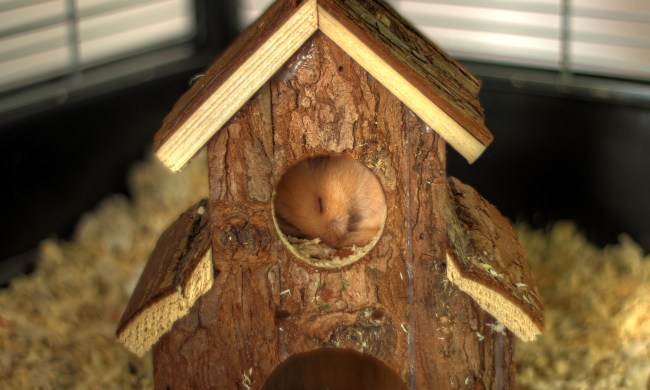When the weather gets warmer, you love to spend all your days outside — and your pet may, too. It feels natural for a dog or a cat to take a little recess in the backyard, but other animals want to breathe some fresh air as well. Rabbits, guinea pigs, turtles, tortoises, and birds (in cages) can all go outside for some sunny playtime. Although it will take some thinking ahead and preparation, your pet could learn to love the great outdoors. Here’s how to take your pet out safely.

Check the weather
The perfect day could prove pretty elusive to you and your best bud. Your animal doesn’t want to go outside only to be rained on. On the flip side, be mindful of really warm and sunny weather as many animals overheat without warning. Some pets do well with a bit of sunscreen if that’s an option. Otherwise, wait for a cool, overcast day without any rain or high winds.
Prep your animal
You should make sure she’s in good health before trying to give your beastie outside time. And take stock of her mood on the actual day, too. Leave your pet in if she’s feeling finicky (and try again tomorrow). Always feed her inside first and wait a minute for her to digest before an excursion. Too much change around mealtimes can lead to indigestion. However, a few treats will help ease a nervous pet into the outdoors.
Get some gear
Many cages have wheels and can go out and then right back in. Movable houses like this allow you and your pet to easily transition from indoors to outdoors as much as needed. Otherwise, look into yard setups.
Depending on the species of your friend, you can stick with a cage or leash to get your critter out of the house. Many bunnies like to be taken for a walk, but hamsters probably just want to look at the grass a little from the safety of their pen.

Scout the territory
Your backyard looks perfectly safe and inviting — to you. It could be a big scary place for a little creature with no experience. In addition to protecting them from the sun and large animals, you should think about smaller threats such as ticks and fleas or biting and stinging insects. Just like a human, some of our pets are allergic to bugs, and no one wants a tick biting them. Watch carefully and take any appropriate preparation, topical bug repellent for one.
Ease her into it
Your pet might want to run back inside the second she steps a foot out the door — that’s OK. Remember, inside is all she knows, and it’s safe from loud noises, predators, and scary bugs. Start with a few minutes a day until she warms up to it. You can begin with an in-between by carrying her to the porch, or even safer, the foyer with the door open. After you both adjust, take the plunge into the backyard, sticking by her closely at all times. Check out the area before she ventures out and find the perfect shaded and secluded spot in your yard.
Watch her closely
Even if your animal instantly takes to the outdoors like her wild ancestors, you need to mind her to make sure she doesn’t get out and that nothing else gets in. Never leave your animal alone, even if she seems secure. A furry friend who is not used to the elements may need to be returned inside suddenly. Cover any hazards in the vicinity, too. Pets should never go near pools, for instance (unless you have a swimming pup), as they are at risk of drowning.
Summer presents a magnificent time to bring your pet out for a little rendezvous with you and your family. Whether it’s three minutes or three hours, your animal will be grateful for the change of pace and the interesting new sights and smells. Watch her carefully for signs that she’s not into it, and be prepared to return her to the house if needed. Check in with your vet before leading your fuzzball (or featherball) out into any unfamiliar territory. While all animals will need to take baby steps, you should abandon your quest if she truly hates it. It’s fun only if you both love your nature playtimes.



